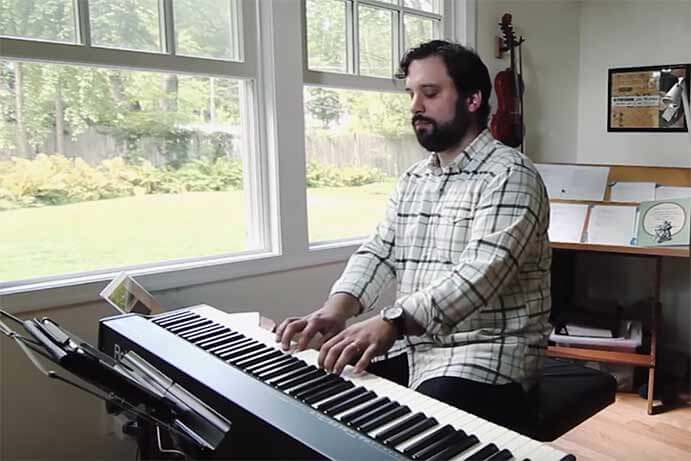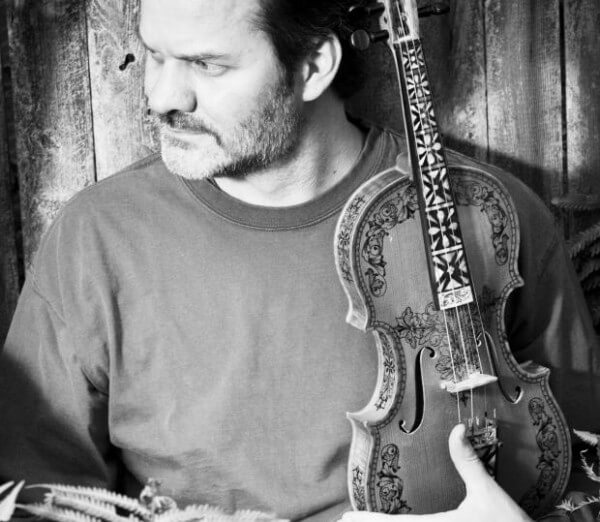The piano is limited in its conventional mode of playing– pianists can only use their fingers to play 88 chromatic keys which hammer quickly-decaying steel strings. Perhaps it is in spite of this limitation that the instrument holds a special place for composers seeking new timbres: from Henry Cowell’s early 20th-century works in which the pianist scrapes and plucks under the lid (now a standard maneuver in new music), to John Cage’s prepared piano which requires small objects to be meticulously woven among the strings, to Per Bloland’s Electromagnetically Prepared Piano which uses magnetic fields instead of hammers. Dan Trueman builds on this lineage of tinkerers with a new software instrument called bitKlavier, a virtual piano played using a keyboard MIDI controller. Nostalgic Synchronic, a collection of etudes for his “prepared digital piano,” is out now on New Amsterdam Records.
Its title is appropriate: the music is at once familiar in its idiomatic gestures that draw from centuries of performance practice, and novel in its coupling with contemporary digital technology. Nostalgic Synchronic cleverly reimagines the “etude” as didactic for the instrument itself rather than the performer. bitKlavier can retune the instrument outside its evenly-divided 12-note octaves, repeat notes in rhythm automatically, and reverse its hammer blows in physics-defying swells of sound– pianist Adam Sliwinski performs these witty and attractive pieces with clarity and sensitivity.

Prelude opens the album with a tour of bitKlavier’s abilities: sharp attacks hover around a single pitch, repeating the upper octave of the instrument in rhythm (reminding me of the stark opening of Ligeti’s Musica Ricercata) before descending to the middle register in a rollicking moto perpetuo, its bent pitches reversing. Undertow ebbs and flows with a series of chords that play forward and backwards in a innocent chorale. This piece and the following Song demonstrate how expressive even a simple piano texture can be with just a little deviation from the normal tuning (they particularly remind me of Randy Gibson’s Aqua Madora and other pieces which use a piano in just intonation).
Wallumrød and Systerslått wander in lopsided folk rhythms reminiscent of Bartók’s Mikrokosmos; actually, derived from Norwegian fiddle tunes, another one of Trueman’s musical pursuits. In Marbles, metronomic repetitions in the lower octave of the piano rebound like dense glass on tile, while skittering microtonal flurries rain down from the upper register. Points among Lines (with Occasional Tantrum) is a toccata that uses the note repeater to great effect, interrupting a not-quite-pentatonic melody with quick, blurry upward lines and dissonant, percussive chords. It is Enough! closes the album with an obscured Bach chorale recomposition, stretched into a dreamy, surreal texture by an insistent underlying pulse and bitKlavier’s ability to reverse notes when keys are released.
The music on Nostalgic Synchronic is highly listenable and likable, but its presentation leaves me with a few questions. First, I take issue with the instrument being called “prepared.” Preparation in the Cagean sense requires a corruption of the original thing, the careful placement of distortions in its regimented form. Connecting a MIDI keyboard to the computer to play bitKlavier is not extending piano technique or creating a novel interface for a software sampler; rather, one merely facilitates the other.

Dan Trueman
Furthermore, I find myself wondering, why piano? Keyboards have been the default controllers for electronic instruments since their early days, and listeners are used to hearing sounds that defy the natural gestures of an acoustic instrument. Yet on Nostalgic Synchronic, there is a slight “uncanny valley” of hearing a piano sound that’s not quite natural but also not quite altered enough to suspend disbelief, especially because the quality of the acoustic piano samples bitKlavier uses is very high. Other electroacoustic music with piano makes this division less uncomfortable by digitally processing the signal of an acoustic instrument or maintaining a clear separation between the piano and electronic sounds. There is no such division with bitKlavier and the music on Nostalgic Synchronic – the instrument instantly responds to every one of Sliwinski’s deft motions, and it is sometimes hard to tell how much the pianist is actually contributing (though this certainly demonstrates the unity of its programming and idiomatic composition). Without a full-bodied instrument in front of the performer, alteration of its tone feels less than revolutionary, especially since there are no physical components that impose their own limitations and possibilities.
However, what is remarkable is not the fact that bitKlavier sounds and is played like a piano, but rather that it presents a new paradigm for bridging standard playing technique, instrument-building sonic exploration, and democratic digital tools. Cage’s Sonatas and Interludes score includes a key of where exactly to place commonly-found objects to create a replicable instrument. For Nostalgic Synchronic, the preparation is only a free download away. bitKlavier is preloaded with many example presets, including those required to perform these etudes. The software also allows the user to experiment with its possibilities and save their own settings. A pianist could precisely perform a piece or perhaps experiment with it like an organist changes registration, a luxury of timbral possibilities not usually afforded to pianists whose fingers remain on the keys. I think Trueman is smart to limit the amount of effects possible: bitKlavier still feels like a real, responsive instrument with natural restrictions, not an intimidating blank slate of overwhelming possibility like a fully-featured digital audio workstation.
Nostalgic Synchronic preserves the accessible and playful spirit of its piano-bending forebears: this is as much a call for a new practice as it is an album of compositions. Perhaps Trueman is vanguard to a wave of digital instrument “builders,” using the legacy of piano modification and the short experiment-friendly form of the etude as a bridge from the mainstream. Composers like Harry Partch, Paul Dresher, Ken Ueno, and Sabrina Schroeder create or modify their own physical instruments and notated repertoires, but the computer is still an emerging tool for completely digital instruments aimed at non-technicians. Of course, musicians have been creating their own novel interfaces and custom performance software since the emergence of digital audio, but largely, these remain idiosyncratic and useful only to their creator. bitKlavier addresses a problem that makes some performers and composers hesitant to approach computer-aided music – it is user-friendly, with the technology as “invisible” to the pianist as the strings under a closed piano lid. I’ll follow bitKlavier’s development with interest, and I hope to see other composers and performers adopt the instrument to extend its sonic palette even further!





















